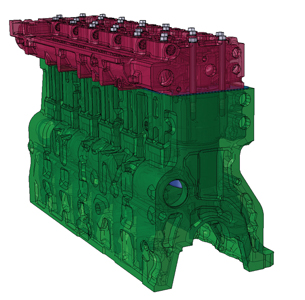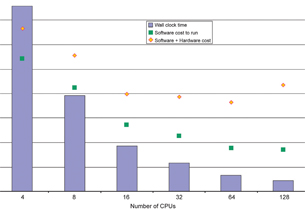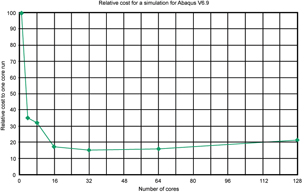Latest News
June 30, 2009
By Frank Popielas
 Abaqus FEA image of a powertrain model as used by Dana Holding Corporation. The CAE department of the engineering company performed two HPC processing-time benchmarks using similar models and found that software upgrades dramatically reduced the number of cores needed for the analysis. |
Engineering companies, like everyone else affected by the current economy, are looking to control expenses. And many seeking to cut resources would be remiss in cutting computer-aided engineering (CAE) resources, and especially CAE engineers who can be seen as the keys to business survival today. In fact, CAE engineers can be considered the best insurance for emerging competitively when the climate improves.
Analysis-led design will keep you focused on what’s really important now: producing quality products cost-effectively. A well-developed CAE system lets you design your product properly upfront and test it virtually before you start prototyping. This helps manage expenses without jeopardizing the business.
Find your “sweet spot” for CAE synergy
In a down economy it is essential to identify the “sweet spot” for your HPC (high-performance computing) system as it runs today’s large, complex models. HPC, used in tandem with the right software, will give you the proper scaling and performance your CAE system demands. The combination of these two elements defines your sweet spot, that synergy of hardware, software, and engineering costs that gives you the lowest expense-per-unit for your product.
A critical way to maximize existing HPC investments is to upgrade with the latest software releases that make best use of hardware performance, minimizing the cost per unit of both hardware and software. Recent developments in software are boosting performance even further, to a point where hardware costs are only a minor factor in simulation costs overall.
Two years ago Dana Holding Corporation of Toledo, OH, performed a software/hardware benchmark study using Abaqus FEA from SIMULIA on a basic powertrain model. At that time, we identified a sweet spot of around 64 cores. Earlier this year we completed beta testing of the latest software release from Abaqus (V6.9) and found that on essentially the same model, we only needed about 32 cores—half what we used two years ago—to hit the sweet spot for a similar FEA analysis. HPC provided some degree of better handling on the hardware side, but the main reason for the cost reduction was improvements made to the software.
 This graph shows wall clock time required for FEA analysis (in this case Abaqus V6.7) of a powertrain model and the cost of software and hardware needed to run the job. Note that with this earlier version of the software the cost minimum (known as the “sweet spot”) did not occur until 64 cores were used. |
Previously, once we passed our CAE sweet spot, costs would increase again. But with the enhanced software scalability of the latest Abaqus release, combined with improved hardware management in place, we find that costs remain almost flat after that. With this system we can use additional cores to speed up our simulation when we are under the gun to meet a deadline, without increasing our expenses.
Boosting CAE resources in this way is certainly easier for large OEMs than for smaller companies. But it’s not enough just to have the resources: you need to be well organized to use them efficiently. At Dana we make sure that whenever there is a new software release, our global CAE team upgrades. We began investing in CAE in a more focused way a decade ago and are now at the point where our hardware and software work in close tandem, with the right system in place to enable all team members to easily communicate with each other.
How leveraging CAE saved a business
An example of how this kind of long-term CAE development strategy pays off can be seen in a large customer of ours. In the past they wasted time and money getting a product to market that was no longer profitable or competitive in their field.
In order to survive, they had to completely re-think the way they did business—and they did it by leveraging the power of CAE. They could have gone the traditional way of slashing costs by just cutting staff, and they did reduce their headcount to some extent. But they also re-examined the way they allocated their existing resources, changing their mindset from an outdated process flow of build-test-error, build-test-error, to a new focus on upfront design. They began investing in CAE technology, using analysis-led design to optimize their product on the computer before cutting prototypes. This helped them keep costs under control while they built up a new technology foundation.
 This graph shows a similar cost analysis to that in the graph at the left, but this time the job was run using Abaqus V6.9. The sweet spot shifted to 32 cores, instead of 64 as seen in the image at left (benchmark study performed two years earlier). This dramatic improvement is largely a result of software upgrades. |
CAE was the key to significantly reducing operating expenses at this company and, even more important, to long-term success as well as building better-quality products. After several years, the company had doubled its market share.
Investing in CAE promotes recovery
How can you start investing in CAE during an economic downturn? You need to take a step back and look at the big picture: Even if you have just a small CAE team in place, you should support them now because they are your starting point for the future. But first make sure you’ve established the basic simulation techniques and standards that fit your product. Only then should you look for an HPC system that will support those needs.
While you may not see immediate results in the current downturn, any delay will only expose your business further. Companies that have established their focus on CAE earlier will lead the recovery in their respective areas and benefit from their focus on analysis-led design.
Hardware and software costs are coming down. What is your company’s sweet spot for a product? What will be the paybacks for your investment? While it’s hard to put an exact figure on returns because they are dependent on how, and how well, you use your CAE capabilities, a return on investment within two years seems very likely. So hang on to your CAE team members, support them at the level you can, and stay close to the leading edge, so you’ll be ready when the economy picks up again.
More Info:
Dana Holding Corporation
Toledo, OH
SIMULIA
Providence, RI
Frank Popeilas is manager of advanced engineering for the Sealing Products Group at Dana Holding Corporation. He has an M.S. in engineering and has been with Dana for 15 years. He is responsible for development of advanced materials, testing, and simulation techniques. Send comments about this article to [email protected].
Subscribe to our FREE magazine, FREE email newsletters or both!
Latest News
About the Author
DE’s editors contribute news and new product announcements to Digital Engineering.
Press releases may be sent to them via [email protected].






